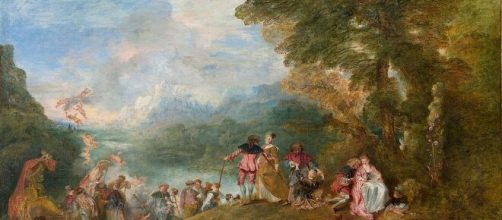This is a case of a news story told backwards, beginning with the headline. Artnet, a self-professed breaking news site, ran this screamer: “This month marks the 300th anniversary of Jean-Antoine Watteau's death.” Month?
Irrational thought
Commemorating the month in which an artist died is bizarre, unless Artnet is savvy about Voltaire being a Watteau contemporary whose novel “Candide” ridiculed rational thought. If the 18th century was the Age of Reason, Voltaire certainly didn’t get the memo.
Bit all of this is beside the point. The news site's absurd commemoration has nothing to do with the story it ends up telling.
Neither does Artnet’s other headline: “Watteau’s beloved depiction of dreamy aristocratic love is a Rococo gem.” Such a declaration amounts to a non sequitur given the story it finally get around to telling. Yes, he used the Rococo style. It was all the rage in 18th century France, particularly adored by Louis XIV owing to its extravagant decorativeness.
The style helped the painter make more than a pretty picture. But you have to slog through Artnet’s miscellany to find it as I’m demonstrating here. Wait for me. The end is near.
In the garden
Given the elaborate landscaping in the formal garden of Versailles, Louis probably read “Candide” down to the last line, “We must cultivate our garden.” Likely, Watteau read this, too, because he worked his subject of gardens to the ground, setting his pictures ad nauseum in cultivated landscapes where romance fills the air complete with serenading musicians.
But if that’s all see, you’re missing the big picture – the hard reality of life that Watteau saw coming – the end of the aristocracy and the start of The French Revolution. Watteau, who suffered from consumption, knew hard truths. Having died at the early age of 36, he understood that sensual pleasure is short-lived.
His paintings are tinged with a wistful sadness. It was the end of life as he knew it, but also as nobility knew it. And that was the news in the Artnet story based on the assumption that most people don’t know that Watteau’s pretty pictures are sad ones.
End of an era
Probably the painting that best illustrates Watteau’s view of love, life and loss is Pilgrims Leaving the Island of Cythera.
An isle sacred to the goddess Venus, this was a place where love lived. Leaving such an environment was tantamount to leaving utopian love.
The couples in the painting, dressed in satins and silks, move slowly and pensively, as if they know they’re headed away from a dream into reality.
Comes the French Revolution
Artnet finally gets to this point with lines like this: “As the ancien regime began its long collapse, Embarkation to Cythera came to be seen as the embodiment of the kind of out-of-touch indulgence that French Revolutionaries could not bear.” According to the news site, the Louvre was so self-conscious just having the painting in its collection that it kept it hidden from view “for its protection.”
So, here’s this gorgeously dreamy painting of a lush terrain under nebulous cloud cover with beautiful people in silks and satins ambling through it telling you that they know there’s no tomorrow for them. Something you’d never guess with a quick glance at the painting or the Artnet report.


